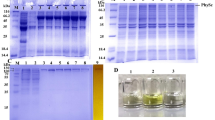Abstract
Thermodynamic aspects of protein stabilization by two widespread naturally occurring osmolytes, β-hydroxyectoine and betaine, were studied using differential scanning calorimetry (DSC) and bovine ribonuclease A (RNase A) as a model protein. The osmolyte β-hydroxyectoine purified from Marinococcus was found to be a very efficient stabilizer. At a concentration of 3 M it increased the melting temperature of RNase A (T m ) by more than 12 K and gave rise to a stability increase of 10.6 kJ/mol at room temperature. The heat capacity difference between the folded and unfolded state (ΔC p ) was found to be significantly increased. Betaine stabilized RNase A only at concentrations less than 3 M. Also, here ΔC p was found to be increased. Calculation of the number of water molecules that additionally bind to unfolded RNase A resulted in surprisingly low numbers for both osmolytes. The significant stabilization of RNase A by β-hydroxyectoine makes this osmolyte an interesting stabilizer in biotechnological processes in which enzymes are applied in the presence of denaturants or at high temperature.
Similar content being viewed by others
Author information
Authors and Affiliations
Additional information
Received: November 16, 1998 / Accepted: March 18, 1999
Rights and permissions
About this article
Cite this article
Knapp, S., Ladenstein, R. & Galinski, E. Extrinsic protein stabilization by the naturally occurring osmolytes β-hydroxyectoine and betaine. Extremophiles 3, 191–198 (1999). https://doi.org/10.1007/s007920050116
Issue Date:
DOI: https://doi.org/10.1007/s007920050116




